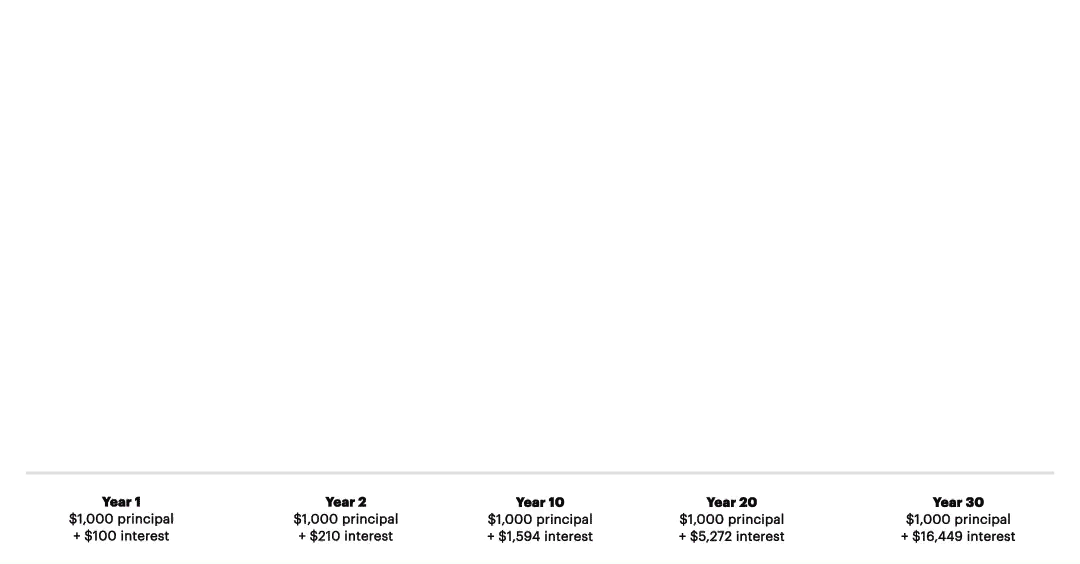How compound interest can supercharge your savings
E*TRADE from Morgan Stanley
Summary: When it comes to saving, compound interest is one of the most powerful tools available to grow your money over time.

Whether you’re saving for the down payment on a vacation home or to pay for your children’s college tuition (one day), compound interest can help your savings move closer toward your goals.
Make your money grow
Compound interest is a mathematical concept that essentially allows your money to multiply and accumulate at a specified rate over time. Compounding means that you earn new returns on the gains you’ve previously made, potentially allowing you to reach your financial goals quicker.
Compound interest can help a bit with short-term goals, like building or supplementing an emergency savings account, or extra padding for a bucket-list vacation. However, over time the “magic” really kicks in, as the gains increase with the longevity of the account. Therefore, compound interest is a great strategy for the funds earmarked for retirement, a child’s college tuition, or a home downpayment.
Here is a hypothetical example just to illustrate the math.
Let's say you deposit $1,000 in an account (that's your principal). If the account earns 10% interest, you've earned $100 after a year.
So far, so good. Now watch what happens the following year:

You've earned more in year two ($110 more, to be exact) without depositing any more money from your pocket! So, what makes compound interest so great? Look what happens if you let your savings ride for 10 or 20 years.
Compounding means that you earn new returns on the gains you’ve previously made, potentially allowing you to reach your financial goals more quickly.
Even bigger savings over time
As shown, the key to compound interest is time, or giving your money time to grow. That’s because the amount that you earn in compound interest gets bigger (and bigger!) each year you let your money accumulate. Also, the more money you put into a compound interest paying account, the more you’ll earn.
Going back to our example again, note the difference in compounding for 10 years versus 30 years.
Understanding interest rates versus investment returns
One more (interest)ing point: while you can get the benefits of compound interest in interest-bearing checking, saving, and investment accounts, there are important differences to understand:
- Checking: You can actually earn compound interest on some interest-bearing checking accounts. The interest compounds daily; therefore, your return may increase or decline if your account balance increases or decreases (although you won’t lose interest you’ve already earned).
- Saving: You won’t lose your principal in a traditional savings account, but when interest rates fall your returns may fall as well.
For example, a $1,000 deposit, with no monthly contributions, compounded annually at a 4.5% APY will yield you a $45 gain after the first year. If the rate falls to 3.5% in the second year, your $1,045 balance, with no additional contributions, will result in a $36.58 gain—a little less than the interest from the first year.
Different types of savings products work in different ways. For example, you may be able to get a higher interest rate on a certificate of deposit (CD) than on a savings account, but, in return, you may have to leave your money in that CD for a specified term. That said, if you don’t need the money right away, a CD can be a wonderful way to lock in compound savings for a portion of your nest egg.
- Investing: If you have an investment account, you can also enjoy the benefits of compound returns—and they’re key to making up for the higher volatility that comes with investing in the market. Unlike with checking or savings accounts, returns on your investments can be both positive (when the value of your stocks goes up) and negative (when stock values go down). In general, however, the long-term returns of diversified stock investments have historically been higher than the amount of interest you’d earn in savings.
How compound interest can help you meet your goals

Start early
While you will earn compound returns as soon as you start saving, the returns blossom exponentially over time. So, the earlier you can begin saving—even if it’s small increments—the better. That’s because your money will have more time to compound, and you may have to save less in order to reach your savings goals.

Stay invested
It is important to make sure you keep your funds invested. Any profits that you withdraw will not compound. So, keep your gains invested and re-invest any payments you might receive, such as interest on savings and bonds or stock dividends.
One more thing to keep in mind: The example above did not include fees or taxes that would likely apply in a real account. So, keep that in mind when deciding how and where to invest your money. Happy Saving!
How can E*TRADE from Morgan Stanley help?
Max-Rate Checking
High yield checking with Annual Percentage Yield1 and no transaction fees
Plus ATM and foreign transaction fee refunds worldwide.2,3 $15 monthly account fee waived with $5,000 average monthly balance.4
Morgan Stanley Private Bank, Member FDIC.
Premium Savings Account
Boost your savings with Annual Percentage Yield5
With rates 9X the national average6 and FDIC-insured up to $500,0007; certain conditions must be satisfied.
Morgan Stanley Private Bank, Member FDIC.
Brokerage account
Investing and trading account
Buy and sell stocks, ETFs, mutual funds, options, bonds, and more.